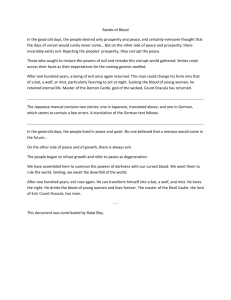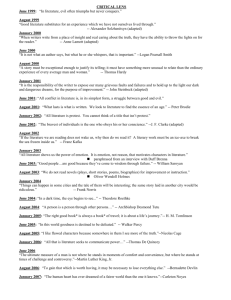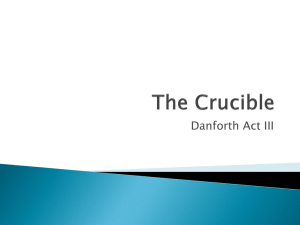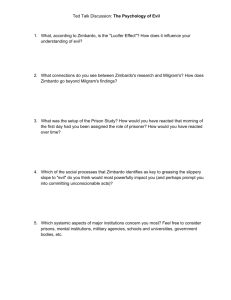Phil Zimbardo “Psychology of Evil” TED Talk 0:16 Philosophers
advertisement
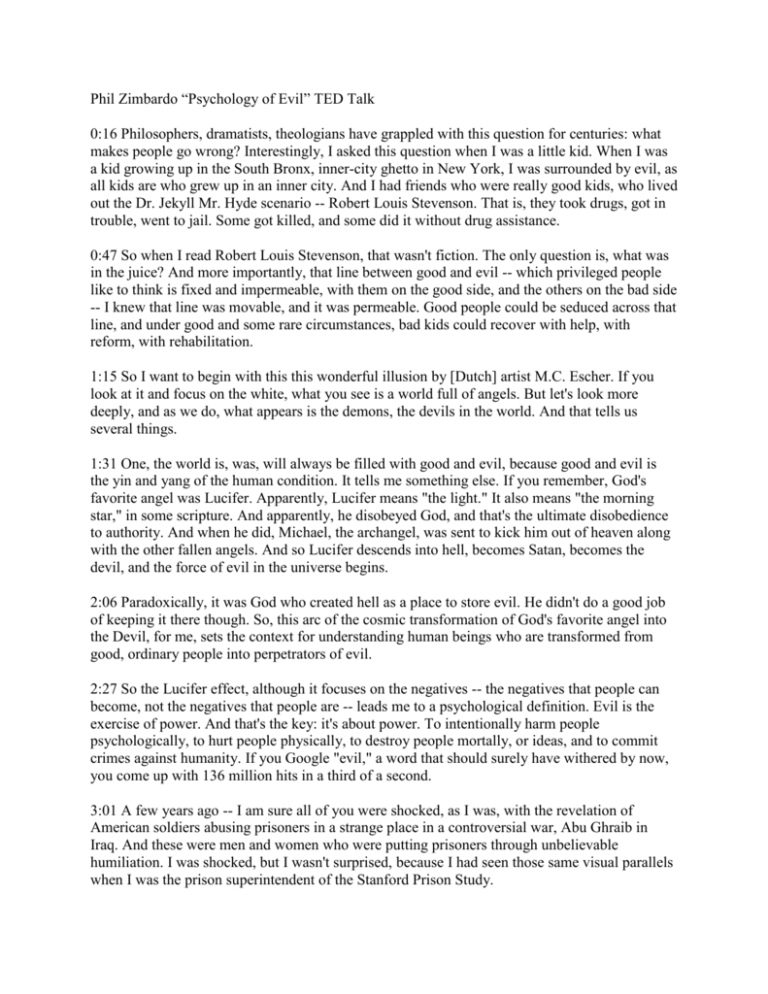
Phil Zimbardo “Psychology of Evil” TED Talk 0:16 Philosophers, dramatists, theologians have grappled with this question for centuries: what makes people go wrong? Interestingly, I asked this question when I was a little kid. When I was a kid growing up in the South Bronx, inner-city ghetto in New York, I was surrounded by evil, as all kids are who grew up in an inner city. And I had friends who were really good kids, who lived out the Dr. Jekyll Mr. Hyde scenario -- Robert Louis Stevenson. That is, they took drugs, got in trouble, went to jail. Some got killed, and some did it without drug assistance. 0:47 So when I read Robert Louis Stevenson, that wasn't fiction. The only question is, what was in the juice? And more importantly, that line between good and evil -- which privileged people like to think is fixed and impermeable, with them on the good side, and the others on the bad side -- I knew that line was movable, and it was permeable. Good people could be seduced across that line, and under good and some rare circumstances, bad kids could recover with help, with reform, with rehabilitation. 1:15 So I want to begin with this this wonderful illusion by [Dutch] artist M.C. Escher. If you look at it and focus on the white, what you see is a world full of angels. But let's look more deeply, and as we do, what appears is the demons, the devils in the world. And that tells us several things. 1:31 One, the world is, was, will always be filled with good and evil, because good and evil is the yin and yang of the human condition. It tells me something else. If you remember, God's favorite angel was Lucifer. Apparently, Lucifer means "the light." It also means "the morning star," in some scripture. And apparently, he disobeyed God, and that's the ultimate disobedience to authority. And when he did, Michael, the archangel, was sent to kick him out of heaven along with the other fallen angels. And so Lucifer descends into hell, becomes Satan, becomes the devil, and the force of evil in the universe begins. 2:06 Paradoxically, it was God who created hell as a place to store evil. He didn't do a good job of keeping it there though. So, this arc of the cosmic transformation of God's favorite angel into the Devil, for me, sets the context for understanding human beings who are transformed from good, ordinary people into perpetrators of evil. 2:27 So the Lucifer effect, although it focuses on the negatives -- the negatives that people can become, not the negatives that people are -- leads me to a psychological definition. Evil is the exercise of power. And that's the key: it's about power. To intentionally harm people psychologically, to hurt people physically, to destroy people mortally, or ideas, and to commit crimes against humanity. If you Google "evil," a word that should surely have withered by now, you come up with 136 million hits in a third of a second. 3:01 A few years ago -- I am sure all of you were shocked, as I was, with the revelation of American soldiers abusing prisoners in a strange place in a controversial war, Abu Ghraib in Iraq. And these were men and women who were putting prisoners through unbelievable humiliation. I was shocked, but I wasn't surprised, because I had seen those same visual parallels when I was the prison superintendent of the Stanford Prison Study. 3:28 Immediately the Bush administration military said ... what? What all administrations say when there's a scandal. "Don't blame us. It's not the system. It's the few bad apples, the few rogue soldiers." My hypothesis is, American soldiers are good, usually. Maybe it was the barrel that was bad. But how am I going to -- how am I going to deal with that hypothesis? 3:46 I became an expert witness for one of the guards, Sergeant Chip Frederick, and in that position, I had access to the dozen investigative reports. I had access to him. I could study him, have him come to my home, get to know him, do psychological analysis to see, was he a good apple or bad apple. And thirdly, I had access to all of the 1,000 pictures that these soldiers took. These pictures are of a violent or sexual nature. All of them come from the cameras of American soldiers. Because everybody has a digital camera or cell phone camera, they took pictures of everything. More than 1,000. 4:19 And what I've done is I organized them into various categories. But these are by United States military police, army reservists. They are not soldiers prepared for this mission at all. And it all happened in a single place, Tier 1-A, on the night shift. Why? Tier 1-A was the center for military intelligence. It was the interrogation hold. The CIA was there. Interrogators from Titan Corporation, all there, and they're getting no information about the insurgency. So they're going to put pressure on these soldiers, military police, to cross the line, give them permission to break the will of the enemy, to prepare them for interrogation, to soften them up, to take the gloves off. Those are the euphemisms, and this is how it was interpreted. Let's go down to that dungeon. 5:04 (Camera shutter) (Thuds) (Camera shutter) (Thuds) (Breathing) (Bells) 6:52 So, pretty horrific. That's one of the visual illustrations of evil. And it should not have escaped you that the reason I paired the prisoner with his arms out with Leonardo da Vinci's ode to humanity is that that prisoner was mentally ill. That prisoner covered himself with shit every day, and they used to have to roll him in dirt so he wouldn't stink. But the guards ended up calling him "Shit Boy." What was he doing in that prison rather than in some mental institution? 7:20 In any event, here's former Secretary of Defense Rumsfeld. He comes down and says, "I want to know, who is responsible? Who are the bad apples?" Well, that's a bad question. You have to reframe it and ask, "What is responsible?" Because "what" could be the who of people, but it could also be the what of the situation, and obviously that's wrongheaded. 7:37 So how do psychologists go about understanding such transformations of human character, if you believe that they were good soldiers before they went down to that dungeon? There are three ways. The main way is -- it's called dispositional. We look at what's inside of the person, the bad apples. 7:51 This is the foundation of all of social science, the foundation of religion, the foundation of war. Social psychologists like me come along and say, "Yeah, people are the actors on the stage, but you'll have to be aware of what that situation is. Who are the cast of characters? What's the costume? Is there a stage director?" And so we're interested in, what are the external factors around the individual -- the bad barrel? And social scientists stop there, and they miss the big point that I discovered when I became an expert witness for Abu Ghraib. The power is in the system. The system creates the situation that corrupts the individuals, and the system is the legal, political, economic, cultural background. And this is where the power is of the bad-barrel makers. 8:32 So if you want to change a person, you've got to change the situation. If you want to change the situation, you've got to know where the power is, in the system. So the Lucifer effect involves understanding human character transformations with these three factors. And it's a dynamic interplay. What do the people bring into the situation? What does the situation bring out of them? And what is the system that creates and maintains that situation? 8:55 So my book, "The Lucifer Effect," recently published, is about, how do you understand how good people turn evil? And it has a lot of detail about what I'm going to talk about today. So Dr. Z's "Lucifer Effect," although it focuses on evil, really is a celebration of the human mind's infinite capacity to make any of us kind or cruel, caring or indifferent, creative or destructive, and it makes some of us villains. And the good news story that I'm going to hopefully come to at the end is that it makes some of us heroes. This is a wonderful cartoon in the New Yorker, which really summarizes my whole talk: "I'm neither a good cop nor a bad cop, Jerome. Like yourself, I'm a complex amalgam of positive and negative personality traits that emerge or not, depending on the circumstances." (Laughter) 9:40 There's a study some of you think you know about, but very few people have ever read the story. You watched the movie. This is Stanley Milgram, little Jewish kid from the Bronx, and he asked the question, "Could the Holocaust happen here, now?" People say, "No, that's Nazi Germany, that's Hitler, you know, that's 1939." He said, "Yeah, but suppose Hitler asked you, 'Would you electrocute a stranger?' 'No way, not me, I'm a good person.' " He said, "Why don't we put you in a situation and give you a chance to see what you would do?" 10:06 And so what he did was he tested 1,000 ordinary people. 500 New Haven, Connecticut, 500 Bridgeport. And the ad said, "Psychologists want to understand memory. We want to improve people's memory, because memory is the key to success." OK? "We're going to give you five bucks -- four dollars for your time." And it said, "We don't want college students. We want men between 20 and 50." In the later studies, they ran women. Ordinary people: barbers, clerks, white-collar people. 10:35 So, you go down, and one of you is going to be a learner, and one of you is going to be a teacher. The learner's a genial, middle-aged guy. He gets tied up to the shock apparatus in another room. The learner could be middle-aged, could be as young as 20. And one of you is told by the authority, the guy in the lab coat, "Your job as teacher is to give this guy material to learn. Gets it right, reward him. Gets it wrong, you press a button on the shock box. The first button is 15 volts. He doesn't even feel it." That's the key. All evil starts with 15 volts. And then the next step is another 15 volts. The problem is, at the end of the line, it's 450 volts. And as you go along, the guy is screaming, "I've got a heart condition! I'm out of here!" 11:14 You're a good person. You complain. "Sir, who's going to be responsible if something happens to him?" The experimenter says, "Don't worry, I will be responsible. Continue, teacher." And the question is, who would go all the way to 450 volts? You should notice here, when it gets up to 375, it says, "Danger. Severe Shock." When it gets up to here, there's "XXX" -- the pornography of power. (Laughter) 11:35 So Milgram asks 40 psychiatrists, "What percent of American citizens would go to the end?" They said only one percent. Because that's sadistic behavior, and we know, psychiatry knows, only one percent of Americans are sadistic. OK. Here's the data. They could not be more wrong. Two thirds go all the way to 450 volts. This was just one study. Milgram did more than 16 studies. And look at this. In study 16, where you see somebody like you go all the way, 90 percent go all the way. In study five, if you see people rebel, 90 percent rebel. What about women? Study 13 -- no different than men. So Milgram is quantifying evil as the willingness of people to blindly obey authority, to go all the way to 450 volts. And it's like a dial on human nature. A dial in a sense that you can make almost everybody totally obedient, down to the majority, down to none. 12:28 So what are the external parallels? For all research is artificial. What's the validity in the real world? 912 American citizens committed suicide or were murdered by family and friends in Guyana jungle in 1978, because they were blindly obedient to this guy, their pastor -- not their priest -- their pastor, Reverend Jim Jones. He persuaded them to commit mass suicide. And so, he's the modern Lucifer effect, a man of God who becomes the Angel of Death. Milgram's study is all about individual authority to control people. Most of the time, we are in institutions, so the Stanford Prison Study is a study of the power of institutions to influence individual behavior. Interestingly, Stanley Milgram and I were in the same high school class in James Monroe in the Bronx, 1954. 13:16 So this study, which I did with my graduate students, especially Craig Haney -- we also began work with an ad. We didn't have money, so we had a cheap, little ad, but we wanted college students for a study of prison life. 75 people volunteered, took personality tests. We did interviews. Picked two dozen: the most normal, the most healthy. Randomly assigned them to be prisoner and guard. So on day one, we knew we had good apples. I'm going to put them in a bad situation. 13:38 And secondly, we know there's no difference between the boys who are going to be guards and the boys who are going to be prisoners. The kids who were going to be prisoners, we said, "Wait at home in the dormitories. The study will begin Sunday." We didn't tell them that the city police were going to come and do realistic arrests. (Video) Student: A police car pulls up in front, and a cop comes to the front door, and knocks, and says he's looking for me. So they, right there, you know, they took me out the door, they put my hands against the car. It was a real cop car, it was a real policeman, and there were real neighbors in the street, who didn't know that this was an experiment. And there was cameras all around and neighbors all around. They put me in the car, then they drove me around Palo Alto. They took me to the police station, the basement of the police station. Then they put me in a cell. I was the first one to be picked up, so they put me in a cell, which was just like a room with a door with bars on it. You could tell it wasn't a real jail. They locked me in there, in this degrading little outfit. They were taking this experiment too seriously. 15:24 Philip Zimbardo: Here are the prisoners who are going to be dehumanized. They're going to become numbers. Here are the guards with the symbols of power and anonymity. Guards get prisoners to clean the toilet bowls out with their bare hands, to do other humiliating tasks. They strip them naked. They sexually taunt them. They begin to do degrading activities, like having them simulate sodomy. You saw simulating fellatio in soldiers in Abu Ghraib. My guards did it in five days. The stress reaction was so extreme that normal kids we picked because they were healthy had breakdowns within 36 hours. The study ended after six days, because it was out of control. Five kids had emotional breakdowns. 16:01 Does it make a difference if warriors go to battle changing their appearance or not? Does it make a difference if they're anonymous, in how they treat their victims? We know in some cultures, they go to war, they don't change their appearance. In other cultures, they paint themselves like "Lord of the Flies." In some, they wear masks. In many, soldiers are anonymous in uniform. So this anthropologist, John Watson, found 23 cultures that had two bits of data. Do they change their appearance? 15. Do they kill, torture, mutilate? 13. If they don't change their appearance, only one of eight kills, tortures or mutilates. The key is in the red zone. If they change their appearance, 12 of 13 -- that's 90 percent -- kill, torture, mutilate. And that's the power of anonymity. 16:39 So what are the seven social processes that grease the slippery slope of evil? Mindlessly taking the first small step. Dehumanization of others. De-individuation of Self. Diffusion of personal responsibility. Blind obedience to authority. Uncritical conformity to group norms. Passive tolerance to evil through inaction or indifference. 16:57 And it happens when you're in a new or unfamiliar situation. Your habitual response patterns don't work. Your personality and morality are disengaged. "Nothing is easier than to denounce the evildoer; nothing more difficult than understanding him," Dostoyevksy tells us. Understanding is not excusing. Psychology is not excuse-iology. 17:15 So social and psychological research reveals how ordinary, good people can be transformed without the drugs. You don't need it. You just need the social-psychological processes. Real world parallels? Compare this with this. James Schlesinger -- and I'm going to have to end with this -- says, "Psychologists have attempted to understand how and why individuals and groups who usually act humanely can sometimes act otherwise in certain circumstances." That's the Lucifer effect. And he goes on to say, "The landmark Stanford study provides a cautionary tale for all military operations." If you give people power without oversight, it's a prescription for abuse. They knew that, and let that happen. 17:53 So another report, an investigative report by General Fay, says the system is guilty. And in this report, he says it was the environment that created Abu Ghraib, by leadership failures that contributed to the occurrence of such abuse, and the fact that it remained undiscovered by higher authorities for a long period of time. Those abuses went on for three months. Who was watching the store? The answer is nobody, and, I think, nobody on purpose. He gave the guards permission to do those things, and they knew nobody was ever going to come down to that dungeon. 18:21 So you need a paradigm shift in all of these areas. The shift is away from the medical model that focuses only on the individual. The shift is toward a public health model that recognizes situational and systemic vectors of disease. Bullying is a disease. Prejudice is a disease. Violence is a disease. And since the Inquisition, we've been dealing with problems at the individual level. And you know what? It doesn't work. Aleksandr Solzhenitsyn says, "The line between good and evil cuts through the heart of every human being." That means that line is not out there. That's a decision that you have to make. That's a personal thing. 18:53 So I want to end very quickly on a positive note. Heroism as the antidote to evil, by promoting the heroic imagination, especially in our kids, in our educational system. We want kids to think, I'm the hero in waiting, waiting for the right situation to come along, and I will act heroically. My whole life is now going to focus away from evil -- that I've been in since I was a kid -- to understanding heroes. 19:14 Banality of heroism is, it's ordinary people who do heroic deeds. It's the counterpoint to Hannah Arendt's "Banality of Evil." Our traditional societal heroes are wrong, because they are the exceptions. They organize their whole life around this. That's why we know their names. And our kids' heroes are also wrong models for them, because they have supernatural talents. We want our kids to realize most heroes are everyday people, and the heroic act is unusual. This is Joe Darby. He was the one that stopped those abuses you saw, because when he saw those images, he turned them over to a senior investigating officer. He was a low-level private, and that stopped it. Was he a hero? No. They had to put him in hiding, because people wanted to kill him, and then his mother and his wife. For three years, they were in hiding. 19:56 This is the woman who stopped the Stanford Prison Study. When I said it got out of control, I was the prison superintendent. I didn't know it was out of control. I was totally indifferent. She came down, saw that madhouse and said, "You know what, it's terrible what you're doing to those boys. They're not prisoners, they're not guards, they're boys, and you are responsible." And I ended the study the next day. The good news is I married her the next year. (Laughter) (Applause) I just came to my senses, obviously. 20:30 So situations have the power to do, through -- but the point is, this is the same situation that can inflame the hostile imagination in some of us, that makes us perpetrators of evil, can inspire the heroic imagination in others. It's the same situation. And you're on one side or the other. Most people are guilty of the evil of inaction, because your mother said, "Don't get involved. Mind your own business." And you have to say, "Mama, humanity is my business." 20:54 So the psychology of heroism is -- we're going to end in a moment -- how do we encourage children in new hero courses, that I'm working with Matt Langdon -- he has a hero workshop -- to develop this heroic imagination, this self-labeling, "I am a hero in waiting," and teach them skills. To be a hero, you have to learn to be a deviant, because you're always going against the conformity of the group. Heroes are ordinary people whose social actions are extraordinary. Who act. 21:18 The key to heroism is two things. A: you've got to act when other people are passive. B: you have to act socio-centrically, not egocentrically. And I want to end with the story that some of you know, about Wesley Autrey, New York subway hero. Fifty-year-old African-American construction worker. He's standing on a subway in New York. A white guy falls on the tracks. The subway train is coming. There's 75 people there. You know what? They freeze. He's got a reason not to get involved. He's black, the guy's white, and he's got two little kids. Instead, he gives his kids to a stranger, jumps on the tracks, puts the guy between the tracks, lies on him, the subway goes over him. Wesley and the guy -- 20 and a half inches height. The train clearance is 21 inches. A half an inch would have taken his head off. And he said, "I did what anyone could do," no big deal to jump on the tracks. 22:03 And the moral imperative is "I did what everyone should do." And so one day, you will be in a new situation. Take path one, you're going to be a perpetrator of evil. Evil, meaning you're going to be Arthur Andersen. You're going to cheat, or you're going to allow bullying. Path two, you become guilty of the evil of passive inaction. Path three, you become a hero. The point is, are we ready to take the path to celebrating ordinary heroes, waiting for the right situation to come along to put heroic imagination into action? Because it may only happen once in your life, and when you pass it by, you'll always know, I could have been a hero and I let it pass me by. So the point is thinking it and then doing it. 22:40 So I want to thank you. Thank you. Thank you. Let's oppose the power of evil systems at home and abroad, and let's focus on the positive. Advocate for respect of personal dignity, for justice and peace, which sadly our administration has not been doing. Thanks so much. (Applause)



